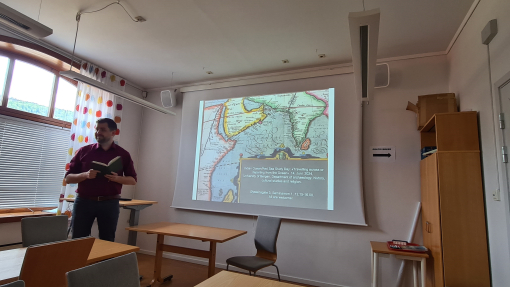Uncovering the hidden histories of the Silk Road
Visions of camel caravans snaking through vast, sun-bleached landscapes laden with silk, spices, and other treasures have long dominated popular understandings of the Silk Road. These romanticised images, often accompanied by squiggly lines plotted onto maps stretching from China to the Mediterranean, evoke tales of Marco Polo, imperial might, and distant empires locked in trade and diplomacy.

We have Ferdinand von Richthofen, who travelled to China and Inner Asia during the latter half of the nineteenth century (and later became the infamous WW1 pilot), to thank for the term “Silk Road” (in its German form Seidenstraße). The empire-centric narratives of that colonial era have also proved surprisingly persistent, despite more recent scholarly critiques.
But as research deepens and historical perspectives broaden, such narratives, largely shaped by 19th-century European colonial scholarship, are increasingly being re-evaluated.
At the heart of this reimagining is Dr Matthew Cobb, Lecturer in Classics at the University of Wales Trinity Saint David (UWTSD). As an advisor on the innovative project Like Islands in a Sea of Sand: Understanding the Silk Roads of late antiquity as a layered network model (SilkRoMo), Dr Cobb is helping to shift focus away from imperial powerhouses to the many smaller, yet critical, actors who sustained these ancient networks.
Rather than viewing the Silk Road as a single, linear route, SilkRoMo investigates the web-like nature of connections across Eurasia during Late Antiquity. Particular attention is paid to lesser-known polities, especially those in the Tarim Basin, whose strategic locations and local agency challenge the conventional empire-centric story.
This new lens has exciting implications not just for research, but also for students and lifelong learners curious about how global networks shaped the ancient world.
“There’s a richness in these overlooked connections,” says Dr Cobb. “Understanding the interplay between imperial frontiers and independent oasis communities reveals a far more dynamic and nuanced history.”
“These smaller communities were not passive bystanders,” he adds. “They were active participants in shaping trade, diplomacy, and cultural exchange across the continent.”
Dr Cobb also notes the importance of reassessing historical frameworks: “By questioning long-held assumptions, we gain a more inclusive and accurate understanding of antiquity that reflects the diversity of voices and experiences involved.”
Expanding the Map: New Projects and International Collaborations
In collaboration with SilkRoMo project-lead Dr Tomas Larsen Høisæter (Western Norway University of Applied Sciences), Dr Cobb is developing a new project exploring networks between the western Indian Ocean, the Indus Valley, and Central and Inner Asia. This North-South axis challenges the traditional East-West framing of the Silk Roads and highlights how regions such as the Indian subcontinent played a central, rather than peripheral, role in Eurasian exchange.
To support this work, Dr Cobb received a Taith international mobility grant to visit Bergen in June 2024, laying the groundwork for a UKRI Curiosity research bid. In May, he also participated in the SilkRoMo workshop Understanding Connections and Mobility in the Ancient and Medieval World at Kyoto University, reinforcing the global academic ties underpinning this research.
The next chapter in this international collaboration will unfold on home ground, with UWTSD set to host a major conference in October titled Going Beyond Empires: Oasis Polities, Imperial Frontiers, and Trade across Ancient Eurasia. The event will gather leading scholars to further interrogate the complexities of connectivity across the ancient world.
Ancient Worlds, Contemporary Relevance
These research initiatives are more than academic - they resonate deeply with UWTSD’s teaching ethos, particularly in its Ancient History and Ancient Civilisations programmes. Modules like Rome and the Indian Ocean: The Classical World in a Global Context offered at MA level mirror the global historical perspective now being championed by SilkRoMo and related projects.
Such modules encourage students to think beyond the boundaries of traditional narratives and consider the diversity, mobility, and mutual influence that defined the ancient world.
“Bringing cutting-edge research into the classroom is central to how we teach,” says Dr Cobb. “Students benefit from seeing how history is constantly being reinterpreted through new evidence and fresh perspectives.”
In this way, the story of the Silk Roads becomes not just one of emperors and merchants, but of everyday people, remote communities, and forgotten kingdoms that helped shape our shared global heritage.
Want to learn more about Ancient History and Ancient Civilisations at UWTSD?
Find out which courses are available by clicking on the following link:
👉https://www.uwtsd.ac.uk/subjects/history-and-archaeology
Further Information
Arwel Lloyd
Principal PR and Communications Officer
Corporate Communications and PR
Email: arwel.lloyd@uwtsd.ac.uk
Phone: 07384 467076
